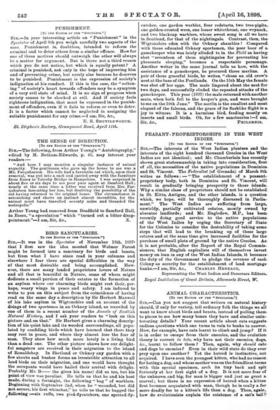ANIMAL CHARACTERISTICS.
[To ME EDITOR Or THE " SPECTATOR:9
SIR,—Can you not suggest that writers on natural history should, if only for variety, tell ordinary folk the things we all want to know about birds and beasts, instead of pulling them, to pieces to see how many bones they have and similar unin- teresting details ? Your recent article about cats suggests endless questions which one turns in vain to books to answer. How, for example, have cats learnt to climb and jump ? If it is in order to escape from their enemies, and the evolution theory is correct in to to, why have not their enemies, dogs, &c., learnt to follow them P Then, again, why should cats and dogs be enemies ? Even in their wild state do they ever prey upon one another ? Yet the hatred is instinctive, not acquired. I have seen the youngest kitten, who had no reason for hating a dog, and whose mother was on the friendliest terms with this special specimen, arch its tiny back and spit furiously at her first sight of a dog. It is not mere fear of the unknown and big, for man is bigger and just as great a marvel ; but there is no expression of hatred when a kitten first becomes acquainted with man, though he is really a far more deadly foe to a kitten's life than a dog. Then, again, how do evolutionists explain the existence of a cat's tail?
What useful purpose does it serve ? It appears rather as a ,cumbrous, dangerous appendage from a purely utilitarian point of view. Again, how can cats have acquired their extreme love of shell-fish, a taste impossible for them to gratify except by man's aid, yet this, too, is instinctive ? Why does a cat use its paws to play with and a dog its mouth exclusively ? A young dog I have now plays by the hour with a ball, tossing it up in his month and racing after it, but if the ball rolls to some difficult place, under a study table, for example, he merely watches it helplessly and never has the sense to put his paw under and so push it out. A cat, on the contrary, scarcely touches a plaything with the mouth (unless it is eatable), using her paws entirely, though a cat I have now carries her toy, usually a piece of paper, in her mouth to her favourite playground, —a bay window. Once more, cats have been domesti- • oa.ted in all probability longer than dogs, yet are still far more independent of man ; a cat washes itself, forages, to a certain extent, for itself, makes up its own mind on the subject of exercise, and entirely declines to subordinate its own views on any subject to ours. In all these things a dog is the very reverse, and though exercise is essential to its health and almost its greatest delight, never attempts to take constitutionals without the companionship of man. Why, again, do the tails of a dog and of a cat express such totally different sentiments? and how has the purr, most cosy of all sounds, been developed ? From a cat's point of view, it seems to serve no useful purpose, nor does it appear to be attractive to other cats ; a handsome, waving tail perhaps may be. These are only trivial questions, but what a blessing it would be if some student could remember the days of his ignorance and try to solve some of the many puzzles in the .life around us instead of dilating on the mere anatomy of dead, skinned, and dissected creatures.—I am, Sir, &c.,



































 Previous page
Previous page